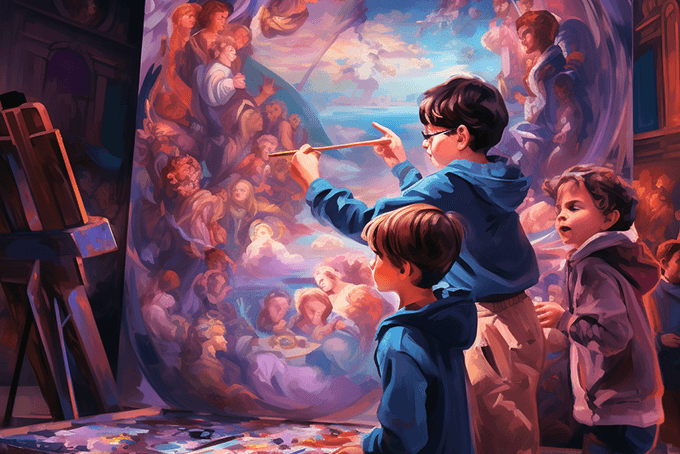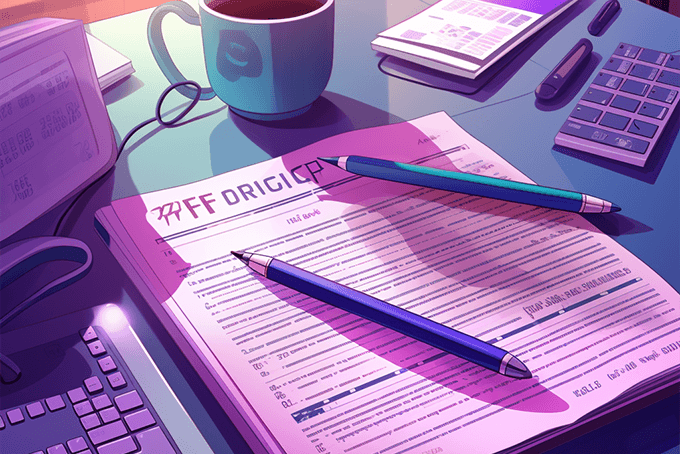Children go through developmental stages in art helping them hone their budding skills and explore their creativity. Once a child figures out they can make somewhat representational squiggles, they have embarked into the Preschematic stage of art. These potato shaped figures with stick arms and legs might not seem like much, but are a child’s first representations of people. Encouraging his drawings aides in his future cognitive and creative development.
The Preschematic Stage of Art
Viktor Lowenfeld, author of Creative and Mental Growth, describes the Preschematic stage as a time when the schema (the visual idea) is developed. A child, between the ages of four and seven, creates drawings during this stage that depict what he finds most important about the objects he views, such as someone’s hair or unique clothing. A child exploring the Preschematic stage doesn’t have full understanding of the dimension and size of objects, so he may draw a person as tall as his house. Color use is also more emotional than logical, expressing a child’s desire for creativity and enjoyment in his art.
Preschematic stage artwork resembles blobs or amoeba shapes with large smiling faces and short arms and legs. Don’t be alarmed with exaggerated features, such as an extremely large nose or mouth – or if the child omits features completely. In other instances, a child may draw a head representing a whole human being, because he finds the head to be the most important part of their body, which he uses to eat, talk, see and hear. When a child draws a self-portrait during the Preschematic stage he often draw himself as the largest shape, as he feels he is the most important, which displays healthy development.
During the Preschematic stage the schema (the internal representation of the world) along with cognitive development are causes the young child’s brain to develop in grand ways. Jean Piaget, a Swiss philosopher and psychologist, finds children go through fixed stages of cognitive development. During the Preschematic stage, Piaget places a child at the Preoperational stage where he is unable to yet form abstract conceptions, and must have hands-on experiences and visual representations in order to form basic conclusions.
Right-Brain/Left-Brain Development
With the right-brain in charge of creativity, but the left more dominant with control over math, rational thought, and linear thinking, the young child entering the Preschematic stage needs help to stimulate his visual cortex and promote use of his creative right-brain, developing a whole human. By introducing and discussing art with the child, he is stimulated to learn more about, and question, the world around him. Involving the child in making decisions about an art activity keeps him interested in creating art and promotes his self-esteem.
Hands-On Activities
Encourage a child to explore the Preschematic stage, along with his Preoperational stage of development, through engaging in lots and lots of hands-on activities to boost cognitive development and self-confidence. Sean Brotherson, a Family Science Specialist, finds that children need simple hands-on experiences for their brains to develop. Activities such as building with blocks, organizing objects based on color or shape, or taking a nature walk along with picking leaves off the ground are wonderful ways to jump-start brain development and get both sides of the brain working together.
Art Activities for the Preschematic Stage of Art
Family Portrait
- Encourage the child to create a family portrait based on a photograph, giving him a visual representation to work with. Look at a family picture together discussing the people in the picture and interesting characteristics of each person, encouraging his observational skills.
- Offer the child markers to use for drawing the family portrait so he can create strong, bold lines. Allow the child to fully explore his preschematic expression of color by using them as he wishes, even if not representational. Encourage the child’s color recognition skills by asking him about the colors he uses as he draws, further helping his cognitive development.
- Once the portrait is finished, help the child write a short paragraph about what he drew engaging the left-brain to work with his creative right-brain.
Nature Collage
- No matter the time of year, getting outside and combining science and art benefits the development of the budding young brain. Provide the child with a small basket for him to pick up items while walking discussing different plants and animals observed, benefiting his preoperative brain.
- Let the child select a large sheet of colored construction paper and invite him to glue the items he collected in any arrangement of his choosing, which gives him hands-on experience for his cognitive development.
- Once the items have been glued to the paper, offer the child a black marker to carefully outline the items in the collage, helping hone his fine-motor skills.
The Preschematic stage is full of discovery and expression. Benefit a child’s development by encouraging him to explore his creativity and learn through engaging hands-on activities, along with spending quality time together, this benefits everyone involved.



